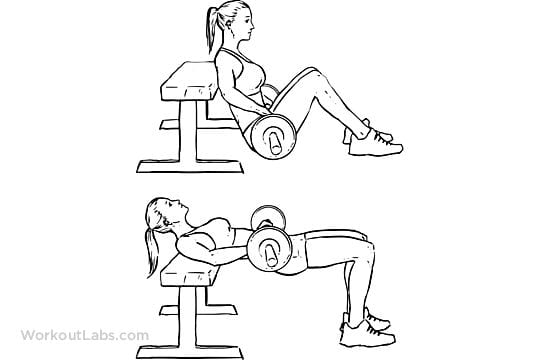The barbell hip thrust (which from now on we will call BHT for simplicity) is a fantastic exercise to train the glutes and hip extensor muscles.
We can actually see it as a variant of the glute bridge (see relevant article here) as the mechanics are similar, but with some differences.
The main difference is (in addition to the fact that in the classic version the glute bridge does not provide overloads unlike the BHT) the support of the back: we will see that this exercise involves the contact of the upper back with a bench and the feet on the ground, amplifying noticeably range of motion relative to the glute bridge.
Again this is a fairly simple exercise for novices, especially as a preparation for exercises with higher loads.
Muscles involved
The BHT is an excellent exercise for the involvement of the gluteus and hamstrings, with an important involvement of the core stabilizing muscles.
A study carried out on a sample of 13 women reported by the "Journal of Applied Biomechanics" showed that this exercise has more stimulated the activity of the buttock than the back squat ... so why not trust it?
How is it done?
The execution of the BHT is rather schematic and can be summarized in the following points:
- Position yourself with the upper back on a bench (possibly fixed to the ground or leaning against the wall), the head in a neutral position with the cervical discharged, the hips flexed but the buttock off the ground, the feet on the ground with the heels close to the buttocks.
- From this position get help from a partner to load the barbell: grab it with your hands facing downwards, resting it on your pelvis; without needing to grip it with force, a light grip will suffice to hold it in place.
- Here begins the actual execution: straighten the hip by contracting the abdomen until the pelvis is in line with the shoulders.
- Maintain the position for 2-3 seconds then go down to the starting position.
The main mistake that can be made is to hyperextend the hip leading to arching of the back.
In addition, we must be careful not to involve the quadriceps too much by reducing the load on the buttock, which usually happens when the feet are not firmly on the ground.

Advice
When you start to get used to exercising and pushing, it is normal to want to increase loads: a barbell resting on the pelvis can be annoying, so the main advice is to use a rolled up towel or a piece of mat as a support between the barbell and our body.
Furthermore, it is not said that all the weight we want to add must be loaded on the barbell: for example, we can provide for the use of overloads such as kettlebells, dumbbells or cast iron discs hung at the waist through a belt (pay attention to the distribution of the load that must be central to avoid asymmetric efforts).
Another aspect to pay attention to is the fact that unlike a free body glute bridge, with this exercise we are going to load the spine a lot, risking to accentuate any dormant problems ... for this, first do a check up or talk about it with the your instructor!
Applications
Unlike the glute bridge “cousin”, the BHT is not particularly suitable for circuit training given its rather elaborate preparation phase; therefore wide to the classic series of 10-15 repetitions.
Can I include this exercise in my routine? Yes, for example by using pyramid-style protocols.
Set 1 = 15 reps (1 minute rest)
Set 2 = 10 reps (1 minute rest)
Set 3 = 5 reps (rest 2-3 minutes)
Set 4 = 5 reps (rest 2-3 minutes)
Set 5 = 10 reps (1 minute rest)
Set 6 = 15 reps (1 minute rest)
The load used must be medium-light in sets 1 and 6, medium in sets 2 and 5 and high in sets 3 and 4.
An exercise of simple execution and undoubted effectiveness that hides some pitfalls, certainly a piece of a puzzle that your buttocks cannot miss.


























